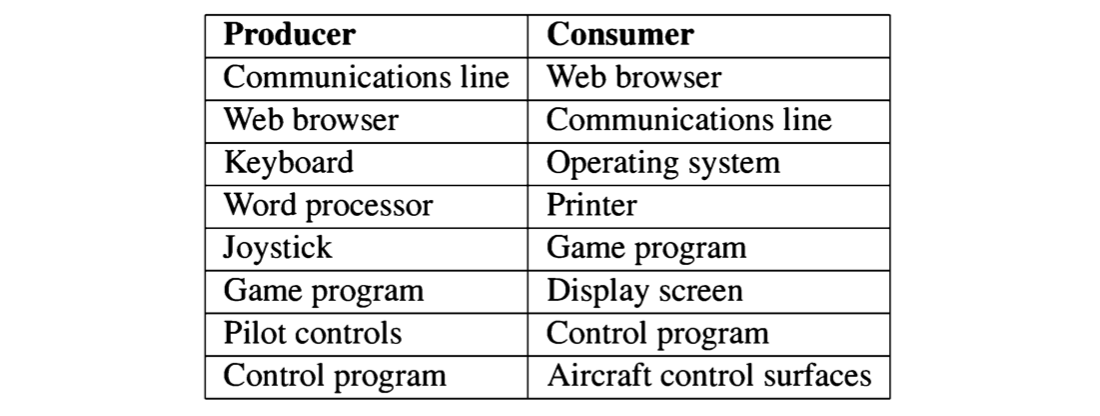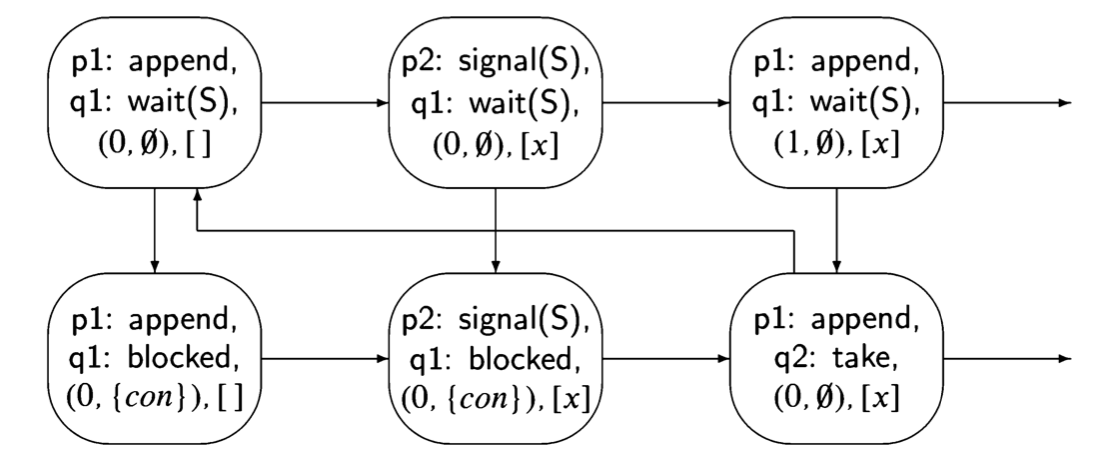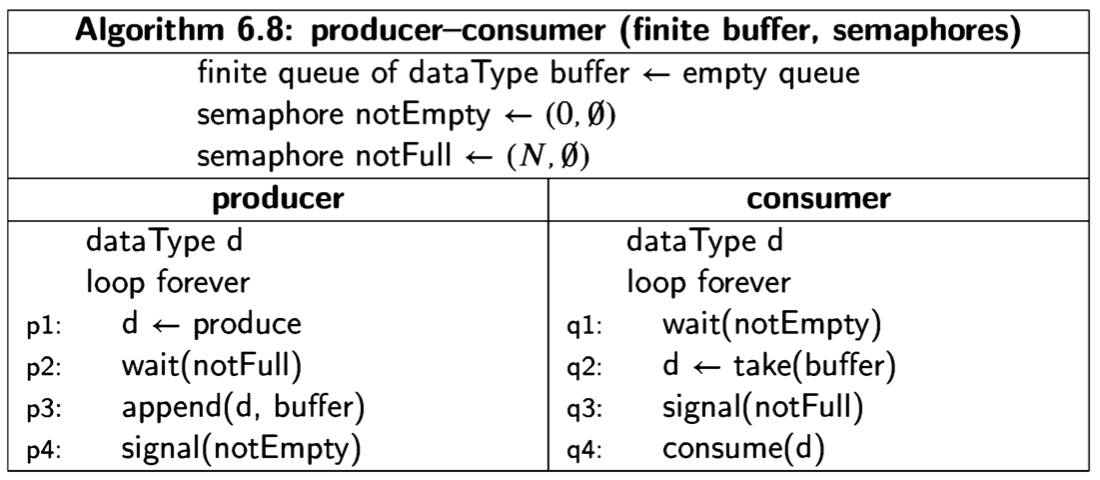The producer—consumer problem
The producer-consumer problem is an example of an order-of-execution problem. There are two types of processes in this problem:
Producers A producer process executes a statement produce to create a data ele- ment and then sends this element to the consumer processes.
Consumers Upon receipt of a data element from the producer processes, a con- sumer process executes a statement consume with the data element as a pa- rameter.
As with the critical section and non-critical section statements, the produce and consume statements are assumed not to affect the additional variables used for synchronization and they can be omitted in abbreviated versions of the algorithms.
Producers and consumers are ubiquitous in computing systems:

When a data element must be sent from one process to another, the communica- tions can be synchronous, that is, communications cannot take place until both the producer and the consumer are ready to do so. Synchronous communication is discussed in detail in Chapter 8.
More common, however, is asynchronous communications in which the communications channel itself has some capacity for storing data elements. This store, which is a queue of data elements, is called a buffer. The producer executes an append operation to place a data element on the tail of the queue, and the consumer executes a take operation to remove a data element from the head of the queue.
The use of a buffer allows processes of similar average speeds to proceed smoothly in spite of differences in transient performance. It is important to understand that a buffer is of no use if the average speeds of the two processes are very different. For example, if your web browser continually produces and sends more data than your communications line can carry, the buffer will always be full and there is no advantage to using one. A buffer can also be used to resolve a clash in the structure of data. For example, when you download a compressed archive (a zip file), the files inside cannot be accessed until the entire archive has been read.
There are two synchronization issues that arise in the producer-consumer problem: first, a consumer cannot take a data element from an empty buffer, and second, since the size of any buffer is finite, a producer cannot append a data element to a full buffer. Obviously, there is no such thing as an infinite buffer, but if the buffer is very large compared to the rate at which data is produced, you might want to avoid the extra overhead required by a finite buffer algorithm and risk an occasional loss of data. Loss of data will occur when the producer tries to append a data element to a full buffer; either the operation will not succeed, in which case that element is lost, or it will overwrite one of the existing elements in the buffer (see Section 13.6).
Infinite buffers
If there is an infinite buffer, there is only one interaction that must be synchronized: the consumer must not attempt a take operation from an empty buffer. This is an order-of-execution problem like the mergesort algorithm; the difference is that it happens repeatedly within a loop.

Since the buffer is infinite, it is impossible to construct a finite state diagram for the algorithm. A partial state diagram for the abbreviated algorithm:

is shown in Figure 6.2. In the diagram, the value of the buffer is written with square brackets and a buffer element is denoted by x; the consumer process is denoted by con. The horizontal arrows indicate execution of operations by the producer, while the vertical arrows are for the consumer. Note that the left two states in the lower row have no arrows for the consumer because it is blocked.
Assume now that the two statements of each process form one atomic statement each. (You are asked to remove this restriction in an exercise.) The following invariant holds:
\[ notEmpty.V = buffer \]

where #buffer is the number of elements in buffer. The formula is true initially since there are no elements in the buffer and the value of the integer component of the semaphore is zero. Each execution of the statements of the producer appends an element to the buffer and also increments the value of notEmpty.V. Each execution of the statements of the consumer takes an element from the buffer and also decrements the value of notEmpty.V. From the invariant, it easily follows that the consumer does not remove an element from an empty buffer.
The algorithm is free from deadlock because as long as the producer continues to produce data elements, it will execute signal(notEmpty) operations and unblock the consumer. Since there is only one possible blocked process, the algorithm is also free from starvation.
Bounded buffers
The algorithm for the producer-consumer problem with an infinite buffer can be
easily extended to one with a finite buffer by noticing that the producer takes
empty places from the buffer, just as the consumer takes data elements from the
buffer (Algorithm 6.8). We can use a similar synchronization mechanism with a
semaphore notFull that is initialized to N, the number of (initially empty) places
in the finite buffer. We leave the proof of the correctness of this algorithm as an
exercise.

Split semaphores
Algorithm 6.8 uses a technique called split semaphores. This is not a new sema- phore type, but simply a term used to describe a synchronization mechanism built from semaphores. A split semaphore is a group of two or more semaphores satis- fying an invariant that the sum of their values is at most equal to a fixed number N. In the case of the bounded buffer, the invariant:
\[ notEmpty + notFull = N \]
holds at the beginning of the loop bodies.
In the case that N = 1, the construct is called a split binary semaphore. Split binary semaphores were used in Algorithm 6.5 for mergesort.
Compare the use of a split semaphore with the use of a semaphore to solve the critical section problem. Mutual exclusion was achieved by performing the wait and signal operations on a semaphore within a single process. In the bounded buffer algorithm, the wait and signal operations on each semaphore are in different processes. Split semaphores enable one process to wait for the completion of an event in another.